Whether you work with a local charity, a nonprofit organization, or any other volunteer-based organization, fundraising events enable you to bring in donations and raise awareness for your cause.
And, planning a nonprofit event is not an easy undertaking.
However, it does not have to be a mission impossible.
In this article, you will learn what a nonprofit event is and the steps you should take to plan your event successfully (complete with a checklist).
We will also highlight the types of nonprofit events you have at your disposal to promote a cause and the benefits of having successful nonprofit events.
Let’s get started.

In this article:
What is a nonprofit event?
A nonprofit event is an event organized by a local charity, a nonprofit organization, or any other volunteer-based organization, to raise donations or bring awareness to a particular cause.
These events could last over a longer period or take place during one day, and can be in-person, virtual, or hybrid — i.e. combine an in-person event and a live stream for virtual attendees to participate in fundraising.
A nonprofit event may use one of the following methods to meet its goals:
- Registration fees,
- Ticket selling,
- Donations during the event,
- Auction items,
- Raffle tickets, and
- Fundraising merchandise.
12 steps for successful nonprofit event planning
To ensure everything goes smoothly while planning your nonprofit event, follow these steps:
- Set goals for your event.
- Assemble the event planning team.
- Choose the event’s type.
- Determine the target audience.
- Set the budget.
- Choose the location.
- Set the date.
- Plan the event’s specifics.
- Recruit volunteers.
- Prepare a promotion plan.
- Track all actions in project management software.
- Follow-up after the event.
Let’s explain what each step entails.

#1 Set goals for your event
When planning an event, the first step is understanding what you want to accomplish and determining how you will measure success.
You can ask yourself the following questions:
- What is the purpose of this event? (e.g. fundraising, building awareness, etc.)
- What cause do we want to promote with our event? (e.g. helping sick children, animal rescue, fighting famine, etc.)
- What’s the outcome we expect? (e.g. donations, mentions in media outlets, etc.)
- How will we measure the success of the event? (e.g. the number of donors we attracted, the amount of money raised for the cause, etc.)
- How long will the event last? (one day or more days)
After answering these questions, make your goals:
- Specific,
- Measurable,
- Attainable,
- Relevant, and
- Time-based.
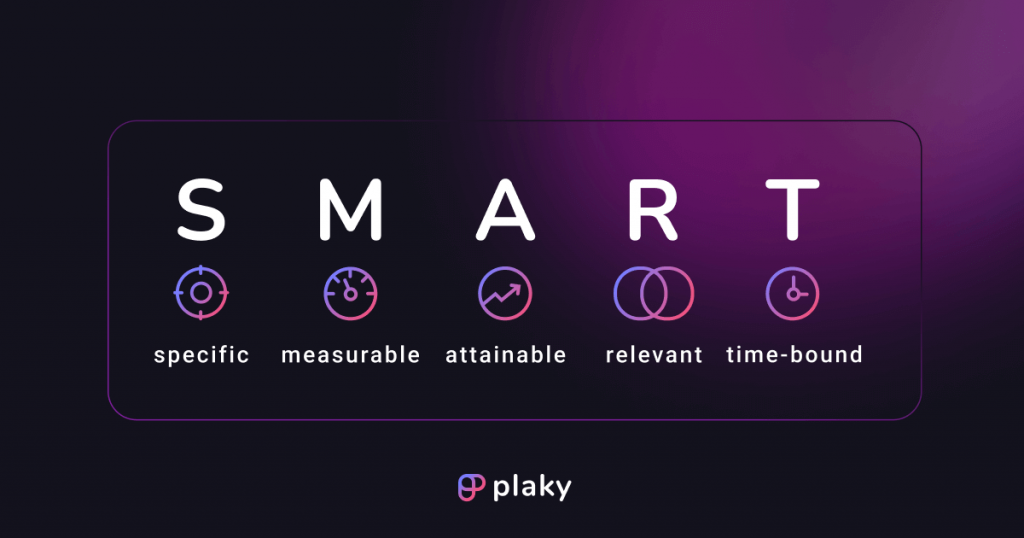
For instance, your nonprofit event S.M.A.R.T. goal may look like this:
We want to donate 1,000 meals as our response to the fight against famine and donate it to local free meal centers. To do so, we will organize a cooking competition event where local restaurants will participate. We have already cooperated with a few local restaurants. The event will last one day.
Here’s how this goal is S.M.A.R.T.:
- Specific: We want to donate meals as our response to the fight against famine and donate it to local free meal centers.
- Measurable: We will donate 1,000 meals.
- Attainable: We will make it possible by organizing a cooking competition that will produce the required number of meals. We have already cooperated with a few local restaurants, so it is achievable.
- Relevant: Our organization fights against hunger.
- Time-based: This will be a one-day event.
#2 Assemble the event planning team
After setting goals, you should assemble your event planning team.
To do so, think about the following:
- How many people do you need on your team?
- How many volunteers do you need?
- What will be the roles and responsibilities of every team member?
You will most certainly need people to lead operations, promotional activities, entertainment, and outreach to potential sponsors, volunteers, and media representatives.
#3 Choose the event’s type
The event type primarily depends on the following factors:
- What do you want to achieve?
- How much money do you have at your disposal?
You can be creative as long as it corresponds to your budget.
For instance, large-scale nonprofit events such as galas and races are ideal for raising larger amounts of money.
On the other hand, if you want to support a local free meal center, organizing a cooking competition with local restaurants can be a better option as meals can be distributed immediately to those who need them.
Suppose you want to provide clothing for homeless shelters. In that case, you can organize a sports competition where clothing companies will participate and ask them to donate clothing instead of money.
#4 Determine the target audience
Knowing your audience will help you drive engagement.
But, how to determine your perfect audience?
First, you need to know what you want to achieve with your event, and then focus on the people that matter most to your nonprofit organization.
You may want to:
- Bring more donors,
- Attract more volunteers, or
- Increase the number of advocates.
To find the right audience,
- Ask yourself why supporters would want to attend your event,
- Survey your current base of donors, volunteers, and supporters to get to know them better and identify their common characteristics, and
- Create attendee personas.
Attendee personas are typical members of your target audience.
Make sure you consider:
- The target attendees’ demographics,
- Where they spend the most time online,
- The target attendees’ preferred ways of communication,
- The target attendees’ goals and challenges,
- Your organization’s role in attaining your attendee persona’s goals and overcoming their challenges.
#5 Set the budget
The amount of money we have at our disposal is, unfortunately, not unlimited.
Therefore, setting a realistic budget is the step you don’t want to take for granted when organizing a nonprofit event.
The scale of the event plays a significant role in determining the budget.
You should also think about the following expenses:
- Venue rental costs,
- Catering,
- Event host(s),
- Decoration expenses,
- Entertainment costs,
- Photographers,
- Security personnel, and
- All other potential expenses, considering the type and scale of the event.
💡 Plaky Pro Tip
To set your budget like a pro, check our guide:
#6 Choose the location
To choose the right location for your event, answer the following questions:
- What is the event’s type?
- What is the size of the event?
- Do you want your event to be inside or outside?
- Are food and beverages available at the location?
- Do you need to obtain legal permits or licenses?
- Do you need to book a venue?
- What is the venue’s capacity?
- Does the venue provide free parking?
- What technical infrastructure do you need for your event?
- Is the location easily accessible?
After answering all these questions, list potential locations and ensure you get all the necessary legal permits.
#7 Set the date
After picking the venue, you need to choose the date for your nonprofit event.
For example, if you are organizing a gala, make sure tickets are available at least a few months before the event.
As another example, you must book a stadium a lot more in advance for sports events.
Getting legal permits and licenses may also take some time, so any event that requires authorities’ approval must be planned months, if not a year in advance.
#8 Plan the event’s specifics
Now it’s time to go into detail about every aspect of the event.
You can start from this list:
- Book the venue.
- Book the catering.
- Contact authorities to obtain necessary legal permits.
- Contact potential guest speakers.
- Prepare sponsorship packages and reach out to potential sponsors.
- Create a website for your event or a dedicated page to make online attendance confirmations or online ticket buying possible.
- Make online donations possible.
- Plan the event’s agenda.
- Think about specific logistics you need for your type of event.
- Plan promotional material.
This is not an ultimate list.
The number of items you may need on your lists depends on your event’s specifics.
So, take time to brainstorm every aspect of your event to ensure you are not missing something important.
#9 Recruit volunteers
There are a few ways you can recruit potential volunteers:
- Use your database and contact volunteers that participated in your past events.
- Announce that you need volunteers on social media and/or on your website.
- Create a press release providing more information about the event and the cause you stand for. Don’t forget to mention that applications for volunteers are open and when the deadline to apply is. Make sure to send it to local media outlets on time.
- Host open days regularly to familiarize potential volunteers with your organization, previously organized events, and the causes it supports. By doing this, you can grow your volunteer base and increase the chances of having their support when needed.
Last but not least — always be kind and respectful to those who decide to support your organization and help promote your activities.
#10 Prepare a promotion plan
It’s vital to spread the word about your event.
But how to promote a nonprofit event?
You can try the following:
- Create a website where people can register and donate online if they cannot attend your event.
- Alternatively, create a new landing page on your existing website.
- Prepare and publish articles about all similar past events to show potential sponsors, donors, and volunteers what they can expect from your current event.
- Create a section on your website dedicated to your long-term volunteers, donors, and sponsors.
- Explore new potential sponsorship opportunities.
- Write a press release and email it to news outlets.
- Promote your event on social media.
- Send newsletters to people from your donor base.
- Arrange participation in relevant talk shows and podcasts.
#11 Track all actions in project management software
It’s always helpful to have all critical information in one place.
So, we recommend using project management software to manage your nonprofit event.
As a nonprofit organization, you are probably careful with spending your resources. Fortunately, there are free project management options like Plaky that offer everything you need to plan your event.
You don’t have to start from scratch — Plaky offers two useful templates you can turn to:
- Nonprofit campaign template, and
- Donors list template.
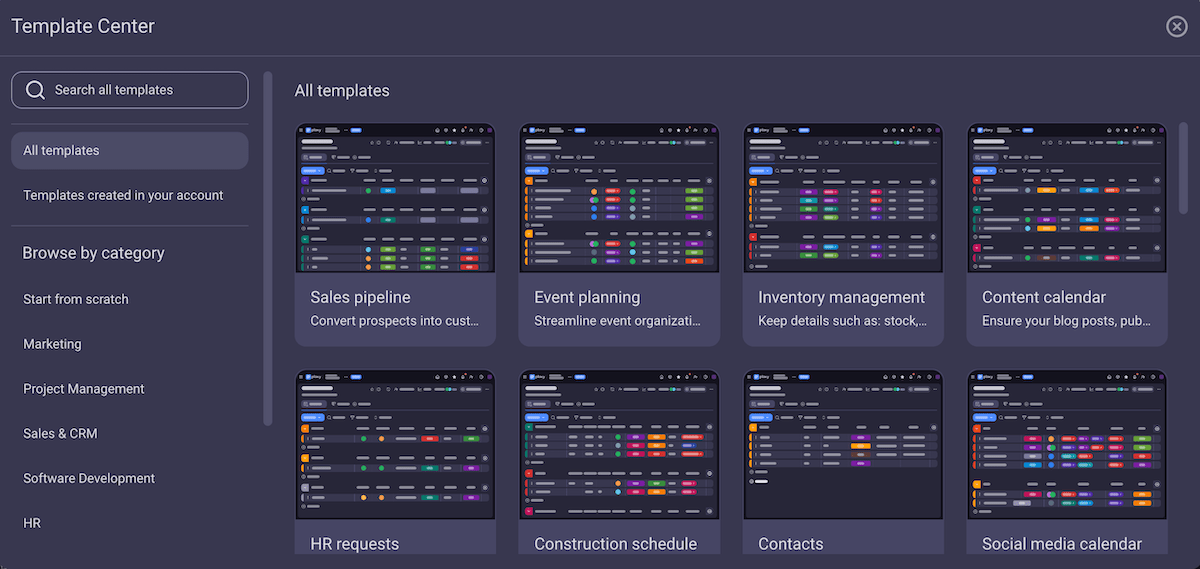
A nonprofit campaign template contains:
- Group of items — where you can group similar tasks,
- Person field — where you can assign people to individual tasks within groups,
- Status filed with customized labels — where you can see at a glance if everything is going according to plan, and
- Date field — where you can set deadlines for tasks.
Get our nonprofit campaign template
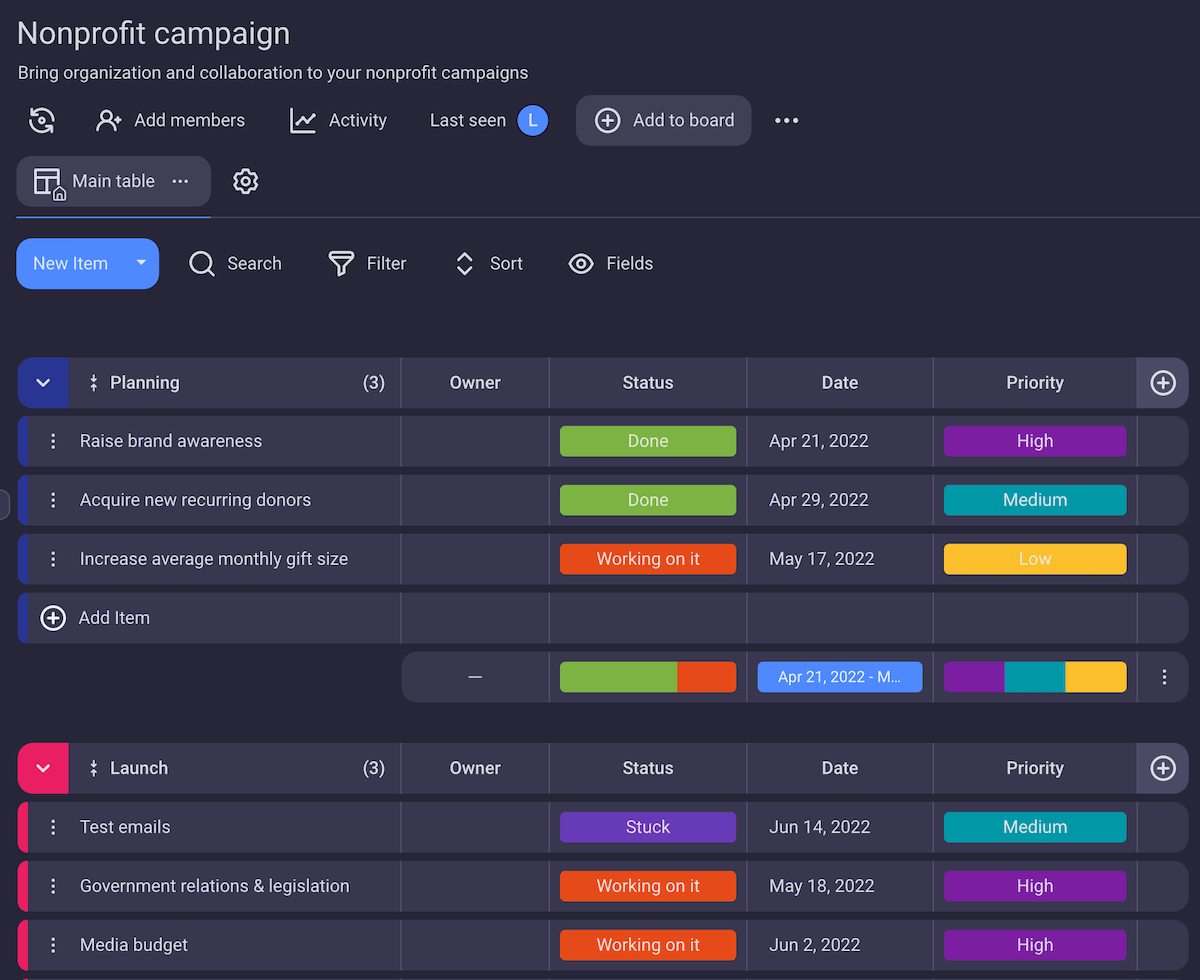
You can use a nonprofit campaign template for every stage of your nonprofit event — from the planning phase to the post-event retrospective.
A donors list template contains:
- Group of items — Where you can group similar tasks together,
- Person field — where you can assign people to particular tasks,
- Text field — where you can describe what the assignee needs to do,
- Status field with customized labels — where you can see how work progresses, and
- Date field — where you can set and track the due dates for individual tasks.
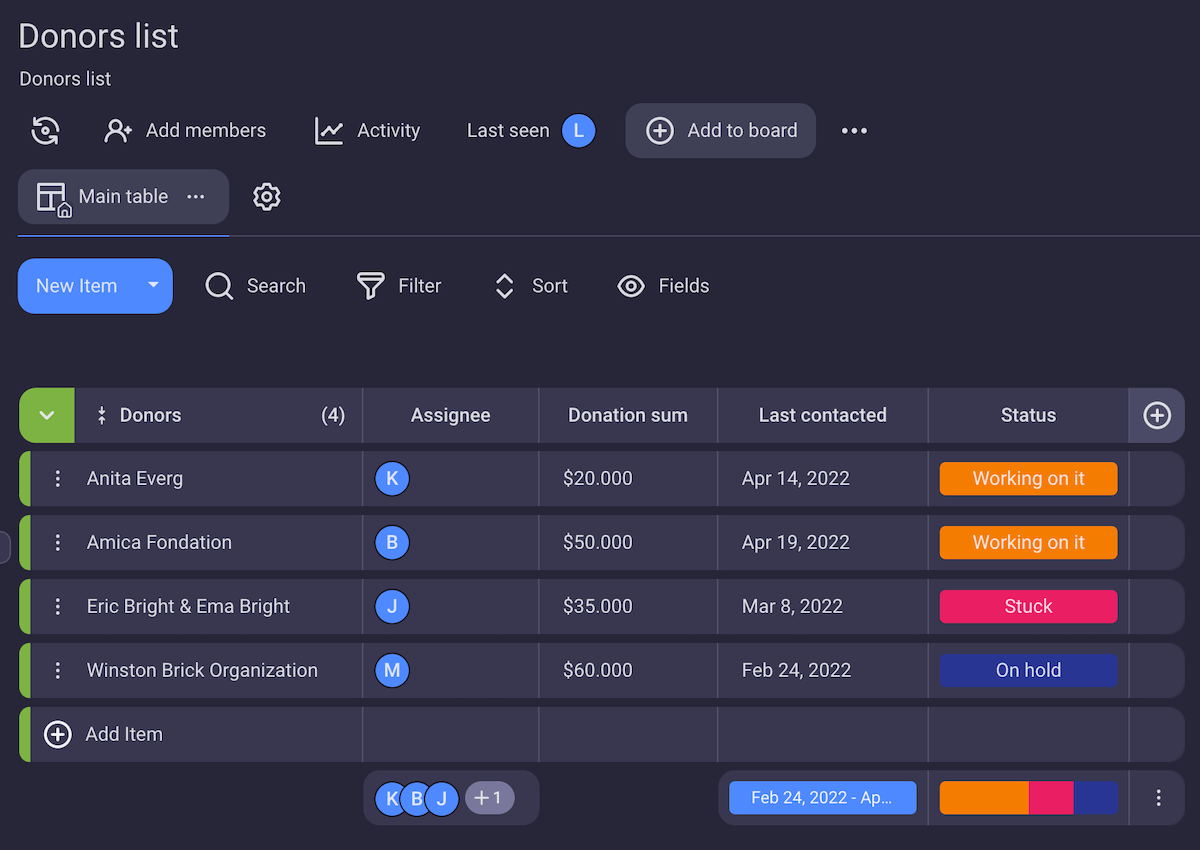
By using a donors list template, you can track all donations and check when your last contact with a certain donor was.
You will be able to maintain relationships with donors and stay in touch with them even if you don’t have an upcoming event.
Staying connected with your donors is an excellent way to build stable relationships and secure their support for future events.
#12 Follow up after the event
In the end, don’t forget to show gratitude and send personalized thank-you emails to your staff, donors, and volunteers.
After all, without them, your nonprofit event would never come true.
You can also send them a post-event survey to identify what improvements could make your future events even better.

Nonprofit event planning checklist
To summarize what you’ve just read, here are the steps you should consider when planning a nonprofit event:
- Identify the goal for your event
- Assemble a planning team
- Choose the event type
- Determine your ideal audience
- Set the budget
- Choose the location
- Obtain any necessary permits or licenses
- Set the date
- Seek event sponsorship
- Identify and confirm speakers/presenters/entertainers
- Finalize the event concept
- Create a dedicated website or a landing page for your event
- Enable online registration for the event
- Launch ticket sales
- Make online donations possible
- Send invitations to your long-term donors
- Recruit volunteers
- Prepare promotional material
- Create a promotion plan
- Finalize the event script
- Organize decorations
- Book catering
- Confirm media attendance
- Finalize the number of guests
- Finalize the number of volunteers
- Create a seating plan (if necessary)
- Test equipment to ensure everything performs as expected
- Prepare registration tables and stock them with necessary items
- Ensure all promo items are on-site
- Send thank-you notes to sponsors, volunteers, speakers/presenters, donors, the media after the event
We know your time is precious. Therefore, we created a free nonprofit event planning checklist to save you time and energy and prevent missing deadlines.
You can get it below and edit it as you want.
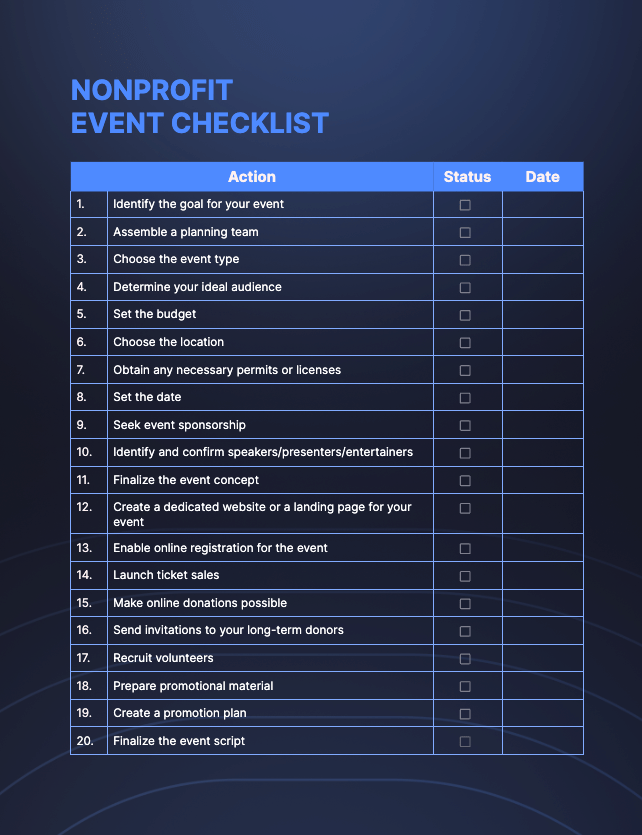
Get our nonprofit event checklist template
Nonprofit event ideas
Some of the examples of nonprofit events may include:
- Auctions,
- Galas,
- Sports events,
- Concerts,
- Races, and
- Cooking competitions.
The idea pool for nonprofit fundraising events seems unlimited.
You can be creative as long as you can find sponsors to support your idea.
Nonprofit auction events
Charity auctions are events in which guests bid to win auction items.
Naturally, the highest bid wins — and the bids tend to be generous, because it’s for charity.
For instance, you can organize an art auction to raise money for scholarships for orphan students.
Nonprofit gala events
Organizing a nonprofit gala is an excellent opportunity to raise a large amount of money for your cause.
However, it is a large-scale fundraising event that requires a lot of planning — and can be expensive.
Therefore, it is more suitable for large nonprofit organizations.
Galas usually include dinner, entertainment, and auctions or raffles. Money is also raised from ticket sales.
Nonprofit sport events
Sports events are fun to participate in and can generate money for your cause in a few ways.
For instance, you can ask popular sports teams to participate in raising money for sick children or environmental or educational causes.
However, sports events are not limited only to professionals.
You can also invite large companies to participate and compete against each other and raise money by selling tickets, food, and drinks during the game.
Nonprofit concert events
Concerts are one of the most commonly used events to raise money for different causes by selling tickets.
They can be smaller scale, with local talents as performers, or large, with celebrities as guest performers.
Hosting a charity concert is an excellent opportunity to raise awareness and increase the number of donors — as these events attract many people.
Nonprofit racing events
Races are a good choice for generating a great deal of money from registration fees.
There are a few race fundraising options, such as:
- Running,
- Biking, or
- Triathlon.
All race participants can wear t-shirts dedicated to the cause the nonprofit organization stands for.
For instance, if you want to raise awareness about breast cancer, all participants should wear pink t-shirts.
As a result of such events, the money your organization raised could cover the costs of preventive medical examinations.
However, organizing a race can be challenging, as you need legal approvals.
Check with your local government about what permits are required for your type of event.
Nonprofit cooking competition
Does your nonprofit organization fight against famine?
Then organizing a cooking competition can be an excellent way to stand up for your cause.
You can ask local restaurants to participate in your cooking contest and donate prepared food to local free meal centers.
The benefits of successful nonprofit event planning
Nonprofit events contribute to:
- Increasing awareness for your cause,
- Growing brand recognition,
- Building a donor database,
- Gaining new sponsors, and
- Establishing long-term relationships with your sponsors, donors, and volunteers.
Let’s briefly explain each benefit of successful nonprofit event planning.
#1 Increasing awareness for your cause
Raising awareness for a cause such as famine, homeless people, or sick children is equally — if not more — important than raising money for the cause itself.
It helps society recognize problems other people deal with. It also helps the cause gain new supporters, and provides the said supporters with a chance to make a difference.
Then, supporters can spread the word about the organization and its activities and attract more people who can help by volunteering at charity events or by providing donations.
Therefore, you should be present on social media and always invite media representatives to your nonprofit events.
The more people get familiar with and speak about the cause, the bigger chances of making a positive change.
#2 Growing brand recognition
Being vocal about the cause you support and organizing charity events frequently can increase recognition for your brand and establish it as a well-known name in the community.
Being on good terms with the media, participating in relevant podcasts, posting regularly about your activities, and sharing relevant news on social media can improve the visibility of your organization.
Being a recognizable name will help you attract more donors and supporters, as people will already be familiar with your activities and causes.
#3 Building a donor database
A nonprofit organization’s primary sources of funding come from grants and donations.
Every event you organize is a chance to expand your donor database.
Even if you already have an extensive donor database, new members are highly desirable to support your efforts by spreading the word about your actions and providing donations in the form of money, food, clothing, or anything else needed.
You can consider adding a free plus one as an option if your event collects donations from selling tickets.
After all, there is a good chance that people attending these events share similar interests with their friends and family. Their plus ones can be your future donors or, at least, spread the word about your organization and charity events in their circle of friends and acquaintances.
#4 Gaining new sponsors
Hosting a flawless event and being transparent about where donations go can help attract new sponsors for your future events.
Suppose the CEO of a renowned company XYZ is unsure whether to support your organization or not and decides to attend your event as a guest to help make a decision.
If the event reflects your professionalism and passion for driving a change and improving society, the previously mentioned CEO may be delighted to support your future efforts.
Your reputation is your best companion in attracting new sponsors, as well as keeping the existing ones.
So, be transparent about donations on your website and prove that you are devoted to making great things happen by keeping in touch with those your organization is helping and listening to their problems and needs.
After all, making the world a better place is the ultimate goal for a nonprofit organization, irrespective of the concrete cause it supports.
#5 Establishing long-term relationships with sponsors, donors, and volunteers
A motivated network of staff and volunteers, along with satisfied sponsors and donors, is the fuel for your efforts going forward.
Therefore, you should think of how to establish long-term relationships with those who help accomplish your initiatives.
As they invest their money and energy to help great things happen, you should keep in touch with them and show gratitude.
Small gestures like sending personalized thank-you letters after the event and dedicating a portion of your website to your major donors, sponsors, and most active volunteers are great ways to express appreciation.

Wrapping up: Use project management software or a checklist to plan your nonprofit event
There is no universal formula for organizing nonprofit events.
You can choose from many types of events, from auctions and galas to cooking and sports competitions. The ultimate goal is to raise awareness about your cause and secure donations.
Planning does not have to be a tedious process. Focus on your cause and use project management software and a checklist template to ensure nonprofit event planning goes smoothly.

